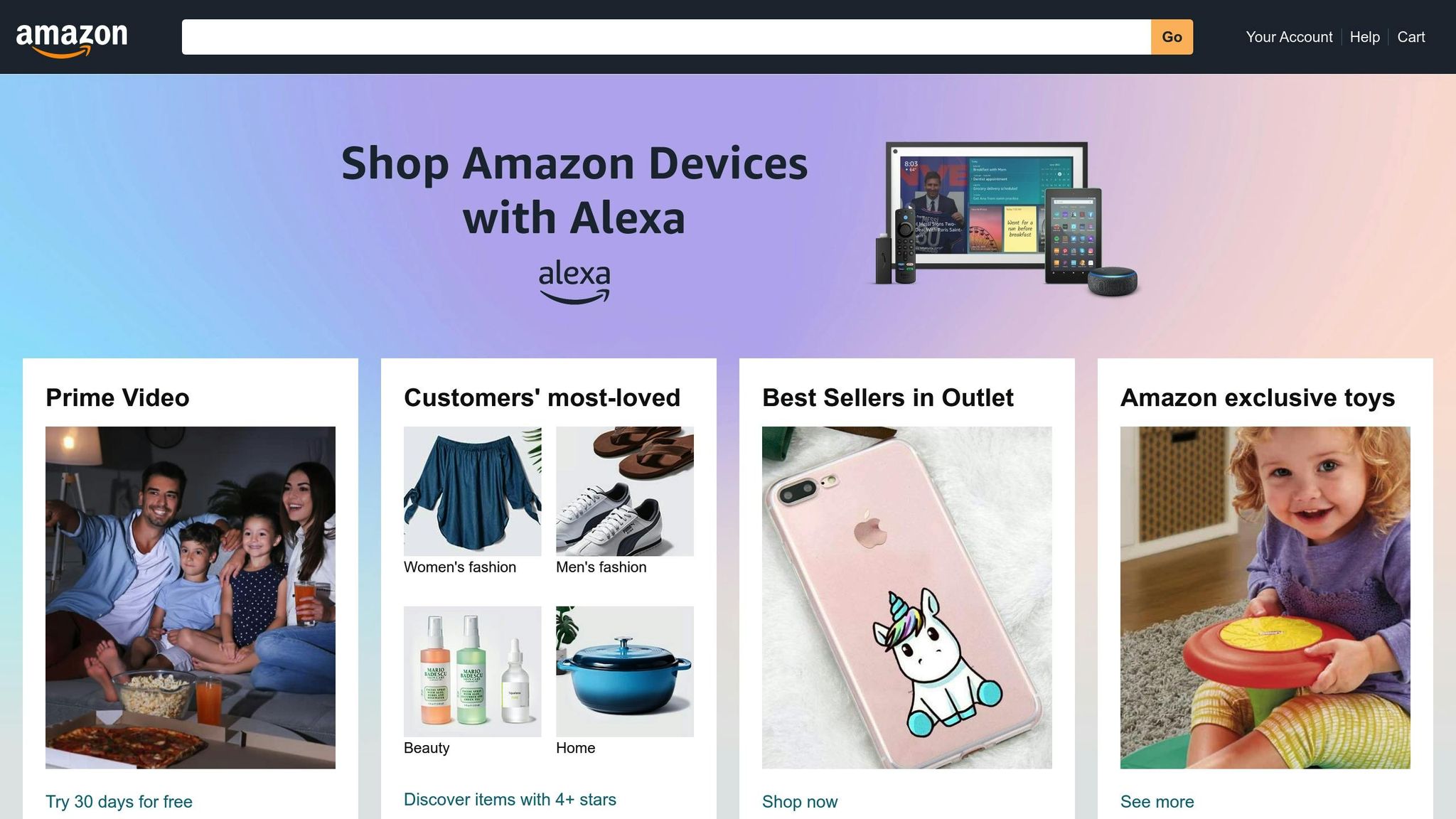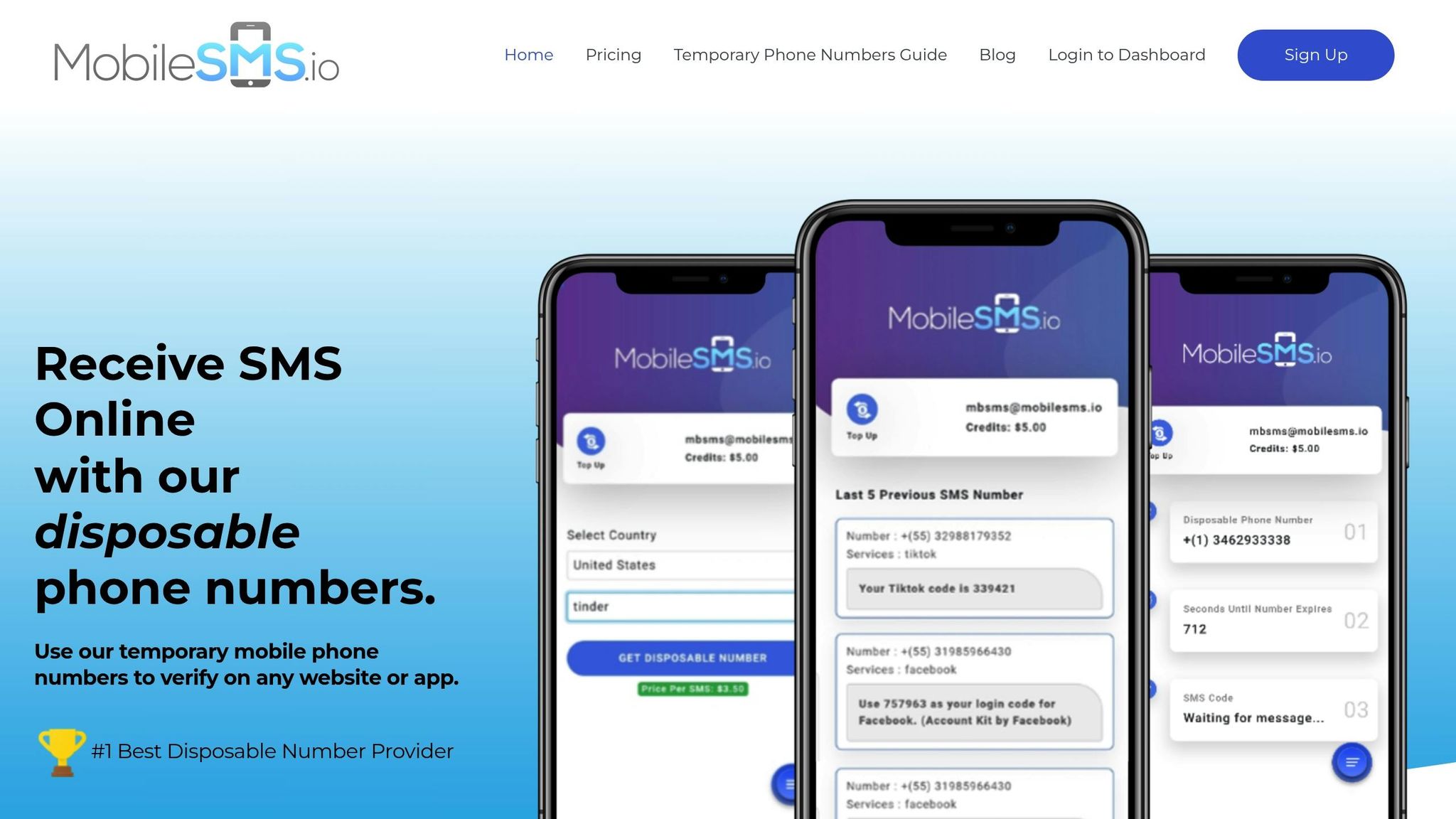Managing multiple Amazon accounts can be challenging, especially with Amazon’s strict policies against account linking. Whether you’re a seller looking to expand or a buyer aiming to separate personal and business purchases, careful steps are essential to avoid account suspension. Amazon tracks shared devices, IP addresses, payment methods, and behavioral patterns to identify linked accounts, so creating and managing accounts requires precise strategies.
Key Takeaways:
- Sellers need explicit written approval from Amazon to operate more than one account.
- Buyers can maintain separate accounts for personal and business use but must avoid overlapping details.
- Amazon uses advanced tracking methods like IP addresses, device data, and payment details to detect linked accounts.
Steps to Manage Accounts Safely:
- Use unique emails, payment methods, and phone numbers for each account.
- Verify accounts with real SIM-based phone numbers (e.g., MobileSMS.io offers reliable options starting at $3.50).
- Maintain separate browser profiles and IP addresses to avoid detection.
- Enable two-factor authentication on all accounts.
- Track financials and policies independently for each account.
Amazon’s Multi-Account Policies Explained
Amazon’s Multi-Account Rules
Amazon has a strict policy allowing only one seller account per individual or business entity, unless you’ve received explicit written approval. If you violate this rule, all linked accounts could face immediate suspension. This policy is designed to prevent manipulative practices, like tampering with reviews or bypassing selling restrictions.
For buyer accounts, the expectation is also one account per person. However, Amazon does recognize that legitimate circumstances – like separating personal and business purchases – may justify having multiple accounts. The key is managing them transparently and within Amazon’s guidelines.
Understanding these rules is crucial to avoiding account linking, which we’ll dive into next.
What Causes Amazon to Link Your Accounts
Amazon uses advanced algorithms to determine whether accounts are connected. Here are some of the main factors that might trigger account linking:
- Shared Devices or IP Addresses: Logging into multiple accounts from the same computer or network can raise flags.
- Payment and Billing Information: Using the same credit card, bank account, or billing/shipping address across accounts makes them more likely to be linked.
- Behavioral Patterns: Similar browsing habits, purchase timing, or overlapping inventory for sellers can also indicate a connection.
For sellers, overlapping product lines are particularly risky. As Riverbend Consulting points out:
"If Amazon believes inventory is being shared across related accounts, it raises a red flag."
Another common scenario involves shared account access. For example, if a consultant manages multiple seller accounts in the same niche – like supplement sales – Amazon may interpret this as shared ownership, potentially linking the accounts.
While these technical factors are critical, legal and compliance issues add another layer of complexity when managing multiple accounts.
Legal Requirements in the United States
Managing multiple Amazon accounts in the U.S. comes with legal responsibilities that extend beyond Amazon’s internal policies. For sellers, tax reporting is a major consideration. Each account generates its own tax documentation, which must be accurately reported to the IRS. Additionally, state regulations may require separate business registrations for accounts serving different markets.
Identity verification is another key requirement. Providing false information or attempting to bypass this process can lead to account suspension and even legal consequences. Sellers are also subject to consumer protection laws, including FTC guidelines and state-specific rules, regardless of how many accounts they operate.
The penalties for violating these rules can be severe. Account suspension often results in immediate revenue loss, with Amazon holding funds for 90–180 days. AMZDUDES warns:
"Failure to comply with these guidelines can result in Amazon listing suspension or permanent account banning."
For sellers with multiple accounts, the stakes are even higher. If one account violates Amazon’s policies, all linked accounts could face suspension. Riverbend Consulting elaborates:
"If one linked account is suspended for policy violations, the other accounts may also face suspension."
Amazon’s enforcement is unforgiving. If an account is banned for violations, creating a new account is strictly prohibited, effectively barring you from the platform.
Real-life examples highlight these risks. In one case shared by Riverbend Consulting, a seller who neglected to ship college textbooks years earlier tried to open a new account for a different brand. Amazon linked the accounts and shut them down immediately. In another instance, an electronics seller with a history of order defects saw his newly thriving account flagged and suspended when Amazon discovered its connection to the old account. These stories emphasize Amazon’s long memory and the importance of resolving past issues before attempting to start fresh.
Complying with legal standards is just as critical as implementing technical safeguards to protect your accounts.
Tools You Need for Secure Amazon Account Creation
When setting up an Amazon account, having access to real SIM-based phone numbers is essential for seamless SMS verification.
Why Use Real SIM-Based Phone Numbers?
Amazon requires every account to go through phone number verification. To ensure smooth access, you need numbers issued by mobile carriers – not VoIP numbers. VoIP numbers often fail Amazon’s verification process, while SIM-based numbers consistently meet their requirements. Services like MobileSMS.io specialize in providing these reliable numbers.
MobileSMS.io offers disposable, SIM-based phone numbers from over 100 countries, with a strong focus on U.S.-based numbers. Their success rate is impressive: 99.7% acceptance compared to the roughly 40% success rate of VoIP numbers. Pricing for one-time verification starts at $3.50. For longer-term needs, rental options include $15 for 7 days and up to $100 for 90 days.
Another standout feature is their pay-per-success model – you’re only charged when the verification code is successfully received. This eliminates unnecessary expenses and ensures a reliable solution for creating and managing Amazon accounts securely. By simplifying the SMS verification process, MobileSMS.io plays a key role in safeguarding your Amazon account setup.
How to Create and Manage Multiple Amazon Accounts
If you’re considering managing multiple Amazon accounts, it’s essential to approach the process methodically. Each account must operate as a distinct entity with its own digital identity, ensuring compliance with Amazon’s policies and reducing the risk of account suspension.
Creating a New Amazon Account
To start, you’ll need a clean browsing environment. This means using an antidetect browser with a fresh profile tailored to your target location. Adjust settings like screen resolution, browser plugins, time zone, and language preferences to make the digital identity unique. Each account should have different names, addresses, and birth dates. For seller accounts, consider setting up separate business entities with unique EINs and business addresses.
When creating the account, MobileSMS.io can be invaluable for verifying with dedicated real-SIM numbers. Their 30-day rental option, priced at $30, gives you enough time to establish the account and activate two-factor authentication. Once verified, enable two-factor authentication immediately, preferably through an authenticator app rather than SMS, for added security.
To avoid account linking, assign unique payment methods to each account. Use business credit cards for seller accounts and personal cards for buyer accounts to maintain clear boundaries.
Managing Accounts Long-Term
Effective long-term management requires consistent security practices. For instance, use proxy rotation to maintain a stable geographic digital footprint. Assign a primary location for each account and stick to IP addresses from that region. If you’re traveling, use the same proxy to avoid inconsistencies.
Keep browser profiles separate and maintain consistent login patterns. Amazon monitors login frequency, session duration, and browsing activity. Sudden changes in these patterns can raise red flags.
Regularly check each account for unusual activity, policy updates, and performance metrics. Set up a dedicated email address for every account and monitor these emails frequently to stay on top of policy changes. Missing a critical update could lead to account suspension.
On the financial side, ensure complete separation of records for each account. This is especially important for seller accounts, where you’ll need to track inventory, sales, and tax data independently. Keeping your financials organized prevents errors and demonstrates compliance in case of an audit.
Common Mistakes to Avoid
Managing multiple accounts can be challenging, and some mistakes can jeopardize all your efforts. Here are some pitfalls to watch out for:
- Password reuse is a major security risk. Use unique, complex passwords for every account and store them securely in a password manager.
- Cross-contamination happens when users accidentally mix up accounts. To avoid this, create clear protocols and use visual cues, like distinct browser themes, for each account. Many users find checklists helpful in ensuring they follow the correct procedures.
- Ignoring policy updates can have serious consequences. Amazon frequently updates its terms of service, and violations can lead to suspension. Stay informed by joining Amazon seller forums and subscribing to policy update notifications.
- Poor record-keeping can cause issues during account reviews or audits. Maintain detailed logs of account creation dates, verification methods, associated phone numbers, and payment methods. These records can be critical if Amazon requests verification.
- Rushing the account creation process often leads to mistakes that are hard to fix later. Take the time to configure each account properly, fill out profile details accurately, and establish consistent browsing habits before engaging in significant activities.
sbb-itb-5a89343
Advanced Privacy and Security Methods
Building on the basics, these advanced techniques take your multi-account management and Amazon account security to the next level. By ensuring strict separation between digital identities, you can minimize risks and stay ahead of detection systems.
Identity Compartmentalization
Creating complete digital separation is the cornerstone of managing multiple Amazon accounts effectively. Each account should be treated as if it belongs to an entirely different person, with no overlap or shared details.
Start by setting up dedicated email systems for each account. Use separate email providers – like Gmail for one, Yahoo for another, and Outlook for a third. Each email should have unique recovery options, security questions, and contact details. Avoid using similar usernames or linking these emails in any way.
When it comes to payment methods, keep them completely separate. For buyer accounts, use different credit cards from various banks, ensuring each has a distinct billing address. Prepaid cards or separate PayPal accounts can add another layer of isolation. For seller accounts, create individual business bank accounts, each tied to its own EIN, business address, and financial history.
Phone number isolation is equally critical. This is where services like MobileSMS.io shine. Their 30-day rental SIM numbers, priced at $30, are perfect for ongoing verification needs. For accounts requiring frequent SMS verifications, their Premium All Services option offers automatic forwarding and works across multiple platforms seamlessly.
To further separate your accounts, use different physical addresses. For example, assign your home address to one account, a business address to another, and use a PO box or mail forwarding service for additional accounts. Amazon tracks address usage patterns, so maintaining geographic diversity helps avoid linking.
Once each digital identity is fully compartmentalized, the next step is to safeguard your accounts from fraud and suspicious activity.
Protecting Against Fraud and Suspicious Activity
To keep your accounts safe, monitor for unauthorized access, unusual logins, and policy violations while maintaining realistic usage patterns. Amazon’s algorithms analyze activity like browsing habits, purchase timing, and login locations. Avoid logging into multiple accounts from the same location or within short timeframes.
Phishing awareness is crucial, as attackers often target multi-account users. Be cautious with emails referencing account details. Instead of clicking links, log directly into your Amazon accounts to verify any issues. Set up account notifications for each account separately, using distinct email addresses and phone numbers for alerts.
Financial monitoring is another key step. Keep a close eye on each account’s payment methods for unauthorized charges or failed transactions. Maintain detailed records of which payment methods are tied to which accounts, as mixing them up could create links between accounts.
Prepare for data breaches by isolating each account’s security measures. Use unique passwords, separate two-factor authentication devices, and independent recovery methods for every account. This way, if one account is compromised, the others remain secure.
For ongoing security, tools like MobileSMS.io can make a big difference.
Using MobileSMS.io for Long-Term Account Security
As your number of accounts grows, managing verification becomes more complex. MobileSMS.io simplifies this with features like Slack and Discord integration, which allow team members to access verification codes without sharing sensitive login details. This is especially helpful for businesses managing multiple seller accounts.
If you’re expanding internationally, MobileSMS.io offers phone numbers from over 100 countries. For example, their US-based numbers are ideal for Amazon.com accounts, while their international numbers support region-specific Amazon marketplaces.
For large-scale operations, API integration streamlines the process. MobileSMS.io’s API lets you automate tasks like requesting phone numbers and retrieving SMS codes, saving time and effort. This is particularly useful for agencies or businesses managing dozens of accounts.
To ensure redundancy, keep backup verification methods in place. Having multiple MobileSMS.io numbers active for critical accounts ensures you’ll always have access to verification codes, even if one number encounters issues. Their pay-per-success pricing model makes this an affordable safety net.
Finally, the real SIM advantage sets MobileSMS.io apart. Unlike VoIP numbers, which Amazon often rejects, their carrier-based SIM numbers maintain a 99.7% acceptance rate, giving you confidence that your verification attempts will succeed when it matters most.
Key Takeaways for Managing Multiple Amazon Accounts Safely
Successfully managing multiple Amazon accounts boils down to following a few critical principles: staying compliant with Amazon’s rules, maintaining strict separation between accounts, and implementing strong technical safeguards. Here’s what you need to know:
Amazon has clear policies on account usage. Sellers must secure explicit written permission before creating additional accounts. Buyers, on the other hand, are allowed only one personal account, with any business accounts kept separate and properly documented.
Compartmentalization is key. Treat each account as if it’s run by an entirely different entity. This means assigning unique emails, payment methods, addresses, and phone numbers to each account. Mixing these details across accounts can raise red flags.
Your technical setup matters just as much. For example, use real SIM-based phone numbers for verification. Services like MobileSMS.io offer numbers with a 99.7% acceptance rate, costing around $30 per month. These numbers make SMS verification smoother and reduce the chances of triggering Amazon’s fraud detection systems. For larger-scale operations, consider integrating APIs to automate and simplify the verification process.
To further protect your accounts, use antidetect browsers and residential proxies. These tools help mask device fingerprints and assign unique IP addresses to each account, making it harder for Amazon to connect them.
Lastly, for US-based accounts, ensure your details align with local standards. Use the MM/DD/YYYY date format, dollar signs ($) for currency, and imperial units for measurements. These small but important details help your accounts appear genuine during Amazon’s reviews.
FAQs
What risks come with managing multiple Amazon accounts, and how can I avoid them?
Managing multiple Amazon accounts comes with its challenges, particularly the risk of account suspension or bans. Amazon actively monitors for connections between accounts, such as shared IP addresses, payment methods, or personal details. If these linkages are detected, they can violate Amazon’s policies and result in serious consequences.
To minimize these risks, it’s crucial to keep each account completely separate. This means using unique details for every account, including distinct email addresses, phone numbers, payment methods, and IP addresses. Tools like proxies and secure browsers can help maintain anonymity and prevent any accidental cross-account connections. By adhering to Amazon’s policies and managing accounts with care, you can stay compliant and avoid potential restrictions.
What steps can I take to safely manage multiple Amazon accounts without risking suspension?
To manage multiple Amazon accounts without risking suspension, it’s important to stick closely to Amazon’s policies and guidelines. Start by ensuring you have a legitimate business reason for operating additional accounts, and always seek Amazon’s approval before setting them up. Each account should focus on distinct product lines or brands, with no overlap in inventory or operations.
To minimize the chances of detection, use separate email addresses, payment methods, and non-VoIP phone numbers for SMS verification. It’s also essential to maintain unique IP addresses for each account by using proxies or secure networks. By adhering to Amazon’s rules and keeping accounts clearly separated, you can reduce the risk of restrictions or bans on your accounts.
Why should I use real SIM-based phone numbers for Amazon account verification, and how can MobileSMS.io help?
Using real SIM-based phone numbers for Amazon account verification is crucial because platforms like Amazon typically reject virtual or VoIP numbers. These types of numbers are considered less secure and more prone to misuse, which can lead to account bans or restrictions.
With MobileSMS.io, you get access to genuine SIM-based phone numbers tied to physical SIM cards. This increases the likelihood of successful verification, aligns with Amazon’s security requirements, and helps you avoid potential account problems while keeping your account secure.



